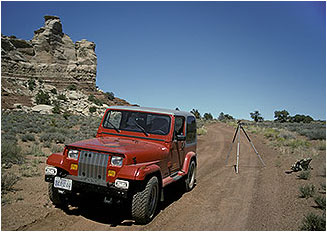|
 Wheeled Travel Wheeled Travel
We have completely given up air travel for transit to photo locations within about 2000 miles, or three days of driving, from our home in Ohio. Even when air travel is possible with the equipment we will be using, I see it as not worth the
ridiculous hassles and restrictions involved. Driving more than 2000 miles gives air travel some big advantages, but that assumes the required photographic equipment can be carried. For instance, we still fly to landscape-only destinations on the west coast, but I find wildlife photography is always compromised if
air travel is required. Think about taking several hefty lenses including a 600mm f/4, shorter lenses, large tripod, Wimberley head, ball head (or a second smaller tripod equipped with a ball head), flash, and all the rest on a plane, and you’ll see why. Fortunately there are many great photo locations that lie well within the magical 2000 mile radius for us, including prime bird locations in Florida, as well as wildlife and scenic locations in the Rocky Mountain region.
.
I joke that the vehicle we use is our most expensive piece of photographic equipment, but I am only half joking. Over the years a few different SUVs have served the purpose. Mid-sized SUVs like the
current Nissan X-Terra and older Toyota 4-Runners seem to be about the right
size, and they have very high ground clearance. On long trips they are big enough for us, our luggage, supplies, and camera
equipment, but not so big they are difficult to maneuver in tight
places. Vehicles like the Chevy Blazer, Toyota 4-Runner, and some
others used to be in this size range, but in recent years they have
become glorified mini-vans that are too wide, too long, too close to the ground, and too
expensive for utilitarian use. Maneuvering them down a rough and narrow trail would be
good for a headache, lots of scratches on the sides, and maybe some
damage to the undercarriage. Four door vehicles work best, providing easiest access to their contents. I have always picked
these high clearance four wheel drive vehicles because we often look for images on primitive dirt roads that are designated “4WD Only”. If this were not the case I think a real mini-van would be my choice. They seem to better lend themselves to photography than do SUVs, they use much less fuel, and are less expensive to maintain.
.
Most vehicles can be made a little more photography friendly with the addition of home-made accessories to keep things safe, organized, and ready for use. For instance, I’ve made a cradle out of dense foam rubber blocks to hold the 600mm f4 lens with a camera attached. It sits on the back seat of any vehicle and keeps the lens and camera from rolling around when stopping or cornering. The camera body hangs off the back of the lens and contacts nothing. This eliminates any concern about the huge amount of force that could be borne by the camera body with a twelve pound lens attached. I have also built a large shelf or platform that fits behind the rear seat. It nearly doubles the capacity of that space and it separates relatively fragile things from heavy luggage and things that are less fragile. For some years now I have not been folding down the rear seats when we pack for travel. The seat back acts as another partition that keeps things like suit cases from smashing things like camera bags and long lenses with cameras attached. Keeping things somewhat organized makes photography easier and it allows for speedier packing and unpacking on days when we change locations. Many photographers use more elaborate setups in their vehicles, but this works well enough for us. Our vehicle is usually filled to capacity, though, and I sometimes decide to leave seldom used equipment at home due to space
considerations.
.
|
|
 Environmental Concerns Environmental Concerns
I have some environmental concerns about the use of these SUVs on our photo
trips. The environmental impact of these vehicles is terrible relative to most other vehicle types.
Our SUV does not see much use beyond these trips, we stay on
designated roads and vehicle trails, and we use the smallest SUV that can reasonably carry our
equipment. It is still a 19 mile per gallon environmental nightmare,
though. Recently some hybrid SUVs have become available, but so far they lack the low-range two speed transfer case and high ground clearance that are required in difficult terrain.
.
Car Rental
When we do not anticipate needing a four wheel drive vehicle we sometimes rent a mid-sized or full-sized car. If gasoline depreciation and maintenance are considered, the total vehicle cost for a given trip can sometimes be less with a rental. This keeps some mileage off of our vehicles, too. We use the rental company that has the best deal at the time. So far, all have been reasonably good.
.
When air travel is required and we need to travel on unmaintained roads to get to our photography locations, we try to rent a Jeep Liberty. We have found these to be very capable vehicles which always have a two speed transfer case.
.
Conclusion
Maybe someday travel won’t be such a hassle and we’ll be able to beam ourselves wherever we’d like to go. Until then we’re stuck with bad airlines and highway rest stops, or perhaps with whatever we can find in our back
yard.
.
Happy traveling,
.

|